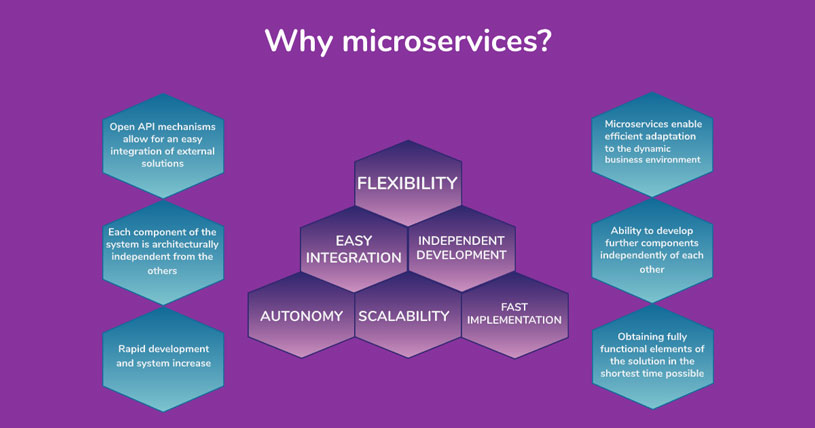Over the past few years, we can notice the growing popularity of microservice architecture, which is slowly pushing out the monolithic architecture that has dominated so far. Microservices, in contrast to monoliths, is a series of many, independent services and processes that create applications. Microservices are a convenient solution when creating an advanced system or large applications – it allows for quick project implementation and parallel work on several modules at the same time. Although such giants as Netflix or Uber based their solutions on microservices, this is not the only thing that makes this approach unique.

Flexibility
Microservices, in contrast to the architecture of monoliths, allow easy modification of functionality in the design. Since each microservice is an independent element of the application, its subsequent components can be changed, supplemented and removed in such a way that it does not affect the functioning of the whole. Therefore, problems such as cyclical change of automatic tests or the risk of stopping the entire application when implementing the next module are eliminated.
Easy integration
Open API, used in the microservice architecture, allows for quick and trouble-free integration with other services. A solution such as API Gateway mediates communication between modules, enabling the convenient adjustment of the API for specific clients, without the need to place it in every microservice.
Scalability
The modular approach allows you to react quickly and effectively to the dynamics of the business environment – changing business requirements does not mean restructuring the entire application, but only the module that relates to the given functionality. Furthermore, in the case of high loads, microservices allow for an efficient increase in the number of instances that balance redundant traffic in the application, which also addresses the problem of performance.
Quick implementation
Microservices provide the possibility of a quick MVP system release. With this architecture, it takes only a few weeks to implement a fully working, basic application that is ready for further development. On the other hand, the addition or modification of existing modules does not complicate the clients’ ability to use the system in any way, because it is less invasive than the monolith architecture, and does not affect the core of the application.
Independent development and autonomy
The distributed architecture also means the independence of design teams. It does not have a central management center, thanks to which the flow of information is smoother. Each team works on “its” application element and does not have to consider the databases or architecture of the other modules. Interestingly, microservices allow you to develop each element in a different technology and language and maintain sites on separate servers and in repositories. Independence understood as such, solves the problem of technical debt and increases the efficiency of the system itself.
Of course, microservices are no medicine for all evil. At the moment, there is no architecture that is free of defects, and at the same time suitable for any type of application. It is no different with microservices. If you are considering implementing a microservice architecture, the key question you should ask yourself is not “Is?”, but “How?”-this is because improper development of technical requirements and structure or lack of careful handling of traffic between servers, can ultimately do more harm than good. Neglecting these issues at the planning stage can cause a classic outpouring of a child with a bath, and as a result, it will most likely turn out that the architecture, which was supposed to facilitate many activities, actually spends all night sleeping. It is worth considering the support of a technical partner with experience in creating solutions based on microservices. Thanks to this, you will bypass many implementation difficulties and at the same time, be sure that you will have an efficient release and system that can be modified flexibly to adapt to rapidly changing business requirements.